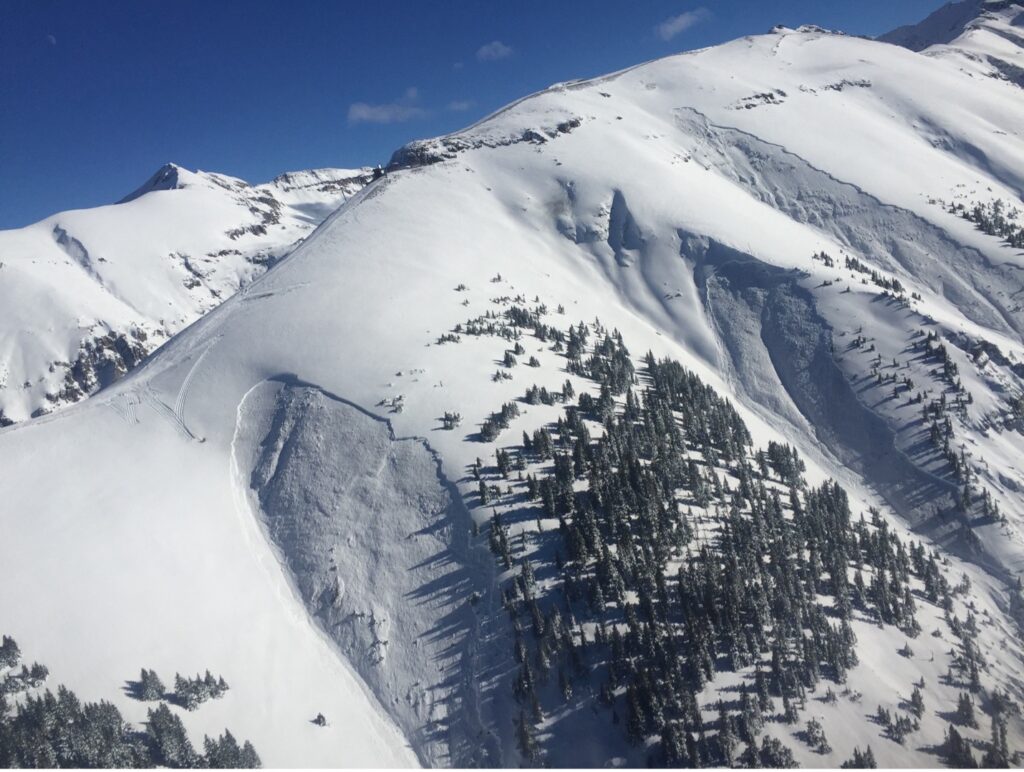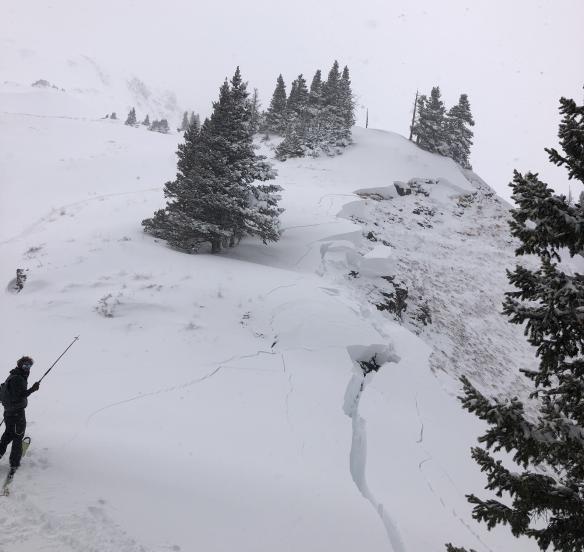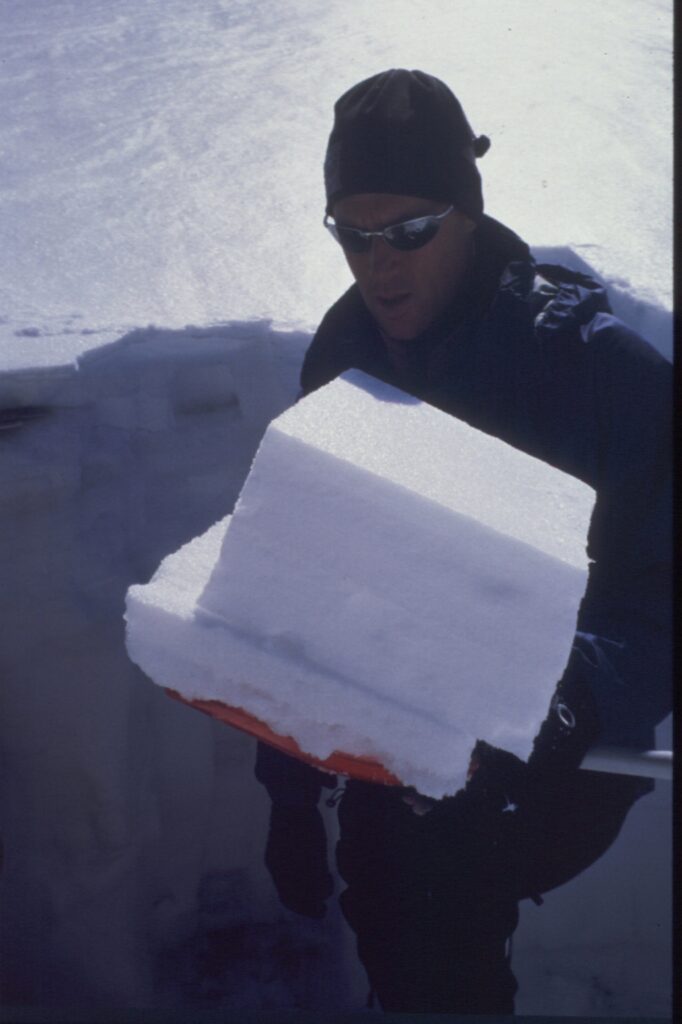Managing Avalanche Risk Part 12: Managing Persistent Slab Avalanches
Photo courtesy of CAIC
At the end of last season we talked about managing storm slabs and wind slabs. While nothing about avalanches is simple, these problems exist in the upper layers of the snowpack so they are more visible than others and the issues tend to be, relatively speaking, short-lived, as the instability generally lasts only days or perhaps a week.
In this article we’ll delve into the murky world of hidden problems that come back to haunt you long after the weak layer is buried—when you may least expect it.
Persistent slab avalanches are related to weak layers that consist of grain types that remain poorly bonded to the snow above and/or below for extended periods of time. A persistent weak layer (PWL) typically consists of faceted grains, melt-freeze crusts, and, especially in the interior snow climates, surface hoar—often in combination with one other. And, technically, a layer is only considered a PWL after an initial avalanche cycle has occurred, the layer has gone dormant, and is then reactivated days, weeks, sometimes months later when snowpack or weather conditions change. While widespread avalanche cycles are common, persistent slab avalanches are often intermittent and isolated, making it hard to see a pattern or predict when and where they might occur.
I could spend this entire article talking just about how these layers form and are distributed over terrain, become initially sensitive to triggering, go to sleep, then wake up again later. But rather than geeking out on snow science, let me tell you a story about an experience with one of these complex and challenging problems, then we’ll talk about things we need to consider when managing them.

On the evening of the Feb. 14, 2010, I arrived for my guiding shift already stressed out by four persistent surface hoar layers in the snowpack that had been plaguing all of western Canada for weeks. Of these, one was classified as “developing,” it was buried but had not yet produced any avalanches. The other three were “dormant,” meaning they had produced avalanches previously but were now lurking below the surface, not doing much, waiting for the right conditions before coming back to life. At our handoff meeting, the outgoing lead guide was very happy to be getting out of the mountains but told me he didn’t think any of these layers would become active until conditions changed. “What kind of change are we talking about?” I asked. “Anything, everything, I don’t know—just be careful,” was his reply.
We had a light snowfall overnight and, as we left for our first run the next morning, temps were rising, but nothing unusual for a typical Monashee morning. On my second run, driving up to a drop-off, I looked out the side window to see the guide of group No. 2 going by in a small slab avalanche as his group watched from a safe spot.
Our already conservative plan was immediately dialed back even more. But then, the snowpack went berserk.
The upper developing layer became active and the middle of the three dormant layers suddenly woke up.
Even thought we stayed on our safest runs, we still triggered over 20 small slabs in those two surface hoar layers. In one case I triggered the upper layer while ski-cutting a small slope to protect an exit route above a steep, convex roll—only to see the second skier behind me trigger the deeper layer while following my traverse. This is not normal—in my 30-plus years in the business at that point, I’d never seen two layers of the same type simultaneously producing avalanches independently of each other. That alone was weird, but get this: I could see old tracks in the bed surface after the second slide ran. One of the slabs I triggered was on a small, 20-degree convex roll that I’d skied scores of times in my six years at this operation. I’d been there in all kinds of unstable conditions, and I’d never before seen that pocket go.
Over the following week or so, things slowly calmed down and we entered into an uneasy truce with the snowpack. Not much was happening, but we remained very nervous about the four surface-hoar PWLs, which we tried to track and test so we could effectively manage associated risks. This was something I’d never had to deal with before.
During this time, we experienced a series of light snowfalls. This process of “incremental loading,” in which each small snowfall adds only minimal additional load but slowly adds up over time, makes it extremely challenging to predict when a developing or dormant PWL will change from stable to unstable. So, around Feb. 21, having skied out most of the runs we considered safe and wondering if we could push out a bit, we carried out a heli-bombing mission.
The bombing mission produced no significant avalanches. Notably, one of the places I put a 12.5-kilogram high explosive shot was at the entrance to a run called Chute. Chute starts off around 20 degrees then rolls over a prominent convexity into steeper terrain below. I blew a huge hole right on the steepest part of the convexity, but no avalanche. OK, I figured—too bad we spent $6,000 and got no results, but at least we’re starting to see that stability is improving.
Throughout this guide shift, the skiing had been exceptionally good. Not over-your-head deep, but really nice soft, dry, cold powder. Still, after weeks or being cautious, I was getting pretty frustrated by the fact that I hadn’t skied much in the way of exciting terrain. After yet another couple of incremental loading cycles with no apparent change in stability, on Feb. 25, the last day of my shift, I made a case in our morning guide meeting for putting a few more (yes, some of my favorite) runs on the green list, which would open them to skiing. My reasoning was that in spite of some crazy events the previous couple of weeks, we were seeing indications that instabilities were settling out. We’d had no significant new load. Slab property really wasn’t an issue. And explosives had produced no significant results.
I bulldozed over the two dissenting opinions, one from a first-year apprentice guide and one from a practicum who had just recently completed their entry-level professional avalanche course. In the end, being the boss and having the most experience in the room, no one was willing to stand up to me and veto when I made Chute green on the run list.
While I did ski some steeper runs that day, I didn’t go into anything really aggressive. As the day was coming to a close, I was relieved. We’d had a fantastic day, everyone was happy, and I was looking forward to seeing my family. On the way back to the lodge, I was chatting with the snow safety team on the radio, and they were saying how remarkable it was that even though they could easily see all the PWLs, they were getting no significant test results. Then, as we arrived at the top of the last hill on the way back to base, I realized we had time for one more run. And it just so happened that we were right at the drop-off for Chute.
On the spur of the moment, I told my driver to stop and unloaded my group. They were excellent skiers, well-disciplined, and they had been very patient and understanding of my daily explanation of how even though the skiing was great, we were having a very unusual year and would be skiing cautiously on moderate terrain. No one was pressuring me to ski more aggressively.
“They’re going to get a surprise when I take them down Chute in perfect conditions on the last run of their last day,” I thought to myself as I put on my pack and stepped into my skis.
We regrouped on a flat spot just above the bomb hole I’d made a few days prior. I asked my group to hold while I made one last check of the slope in front of us before committing to the convex roll.
As I started across, I stayed well above the convexity. The incline where I set my traverse was so low that I had to walk in the knee-deep fluff. I got to the point where I had to decide if we would ski over the convexity using a couple of gullies to get through some small rock outcrops or keep traversing to gentler terrain and a less aggressive line. A small voice in the back of my head urged me to keep going and end the trip with a nice low-stress last run. But I stopped, preparing to give my group instructions for skiing what was going to be the run of the week.

As I started a kick turn to face the group, the voice in my head started screaming. A fracture line about 50cm deep flashed across the slope about 10 meters above me.
“Hmmmm, interesting,” I thought to myself. “That’ll be the Jan. 9 surface hoar coming back to life—again! Bizarre.” I wasn’t too worried at this point; I was on a 15-degree slope and the slab was so soft that it just ran around my legs like water. But being off balance in an awkward position halfway through a kick-turn, I lost my balance when snow started piling up against my uphill leg. In a split second I got pushed into the moving mass of snow and found myself going headfirst over the convex roll onto the near vertical bluff below.
After getting raked through the rocks, I landed on the transition between the bluff above and the 35ish-degree slope below. I got fully covered in the debris flow at this point and thought I’d be stopping there, but nope, the ride wasn’t over. Everything was happening so quickly, I didn’t have time to think about or do anything other than trying to keep the snow away from my face. As I did a somersault, I came out of the snow for a sec and realized I was completely out of control, moving really fast, and heading straight at the massive mid-slope boulder I’d skied past scores of times on this run.
It was at this point that the seriousness of the situation flashed through my brain: “I might die here.”
I finally pulled the trigger on my airbag and ended up a few meters from the boulder buried to my waist, uninjured other than a severely bruised ego and pissed off about losing one of my favorite skis.
I’m sure you’ve noted the obvious while reading my story: Don’t let your desire to ski get the best of your rational decision-making process. Incremental loading makes PWLs even trickier than normal. Even minor changes in weather can bring a dormant PWL out of its slumber. PWLs can go to sleep and wake up many times throughout a winter. Last-minute decisions in unusual situations are a recipe for disaster when they lead to more aggressive skiing. When it’s weird, standard thinking doesn’t apply—who would guess a soft-slab avalanche would start on a 15-degree slope, much less have such serious consequences (hello, terrain traps)?
But to me, the biggest mistakes were in the days leading up to the incident. I did not do a good job of managing my increasing frustration from having had to ski moderate terrain for most of the winter. In spite of having no pressure from my group, I wanted to give them a run to remember—which they did, but for the wrong reason. I let myself believe I was smarter than the average bear—even when I was dealing with a situation I myself had never experienced before. I ignored concerns from others who had less “baggage” than I did. (Read No. 9 in this series for more about that.)

I leave you with this: PWLs can happen in all snow climates. Yes, they are more common in continental and interior snowpacks, but in anomalous seasons they do occur in maritime climates as well. PWL winters are deadly: The worst ones I have experienced (2007-08, 2008-09, 2009-10) saw annual fatality counts almost double the most recent Canadian average, and nearly 90 percent of deaths in those three seasons were associated with PWLs.
Most recreationists do not have the time, training, or knowledge required to effectively assess persistent weak layers and the hazard associated with persistent slabs. I recommend recreational skiers use public avalanche forecasts to keep tabs on conditions in their area rather than trying to outsmart the snowpack and the forecasts. When PWLs and persistent slabs are in play, unless your risk tolerance is quite high, you’ll probably need to spend extended periods of time—in some years even the entire winter—on low-consequence terrain with minimal or no overhead hazard to maintain acceptable levels of risk.
In my next article, I’ll discuss the gnarliest of avalanche risk-management conundrums: low-probability, high-consequence scenarios related to deep-persistent-slab avalanches. Until then, ski safely.
Karl Klassen took his first professional avalanche course in 1979 and spent the next 40 years working as a forecaster, guide, educator, and mentoring up and coming forecasters and guides. During that time he also sat on the Association of Canadian Mountain Guides board of directors including serving as vice president, president, then as executive director. He joined Avalanche Canada in 2004 as a public avalanche forecaster and became the warning service manager in 2009. Recently retired, he lives in Revelstoke, B.C., where he spends his time cycling in the summer and skiing in the winter.
Support The Powder Cloud
The Powder Cloud is dedicated to providing you the education and mentorship required to travel safely and find the happiness in the backcountry.
We’d like to ask for your support—for our scrappy editorial team, our wise and experienced contributors and to help us develop new and creative ways to educate all backcountry skiers and riders.
If you are able, please consider supporting us. Thank you and we appreciate you.
Related Posts
Loading...


